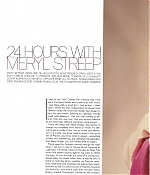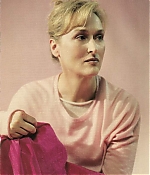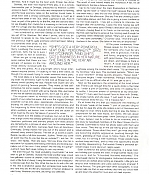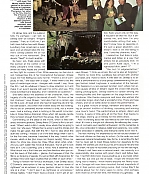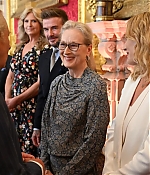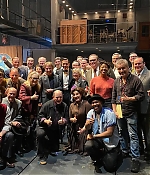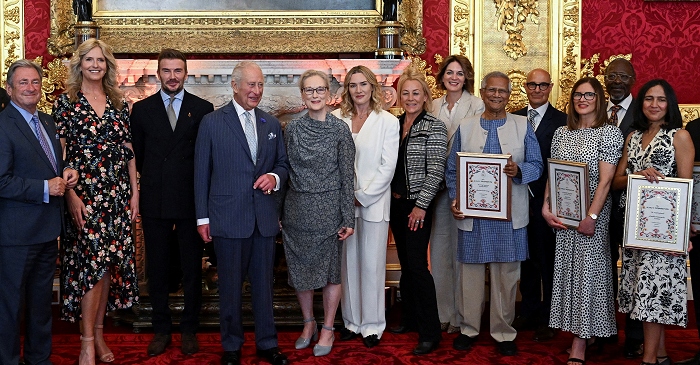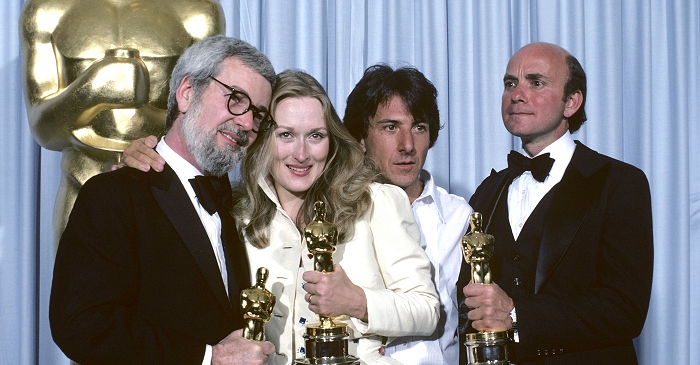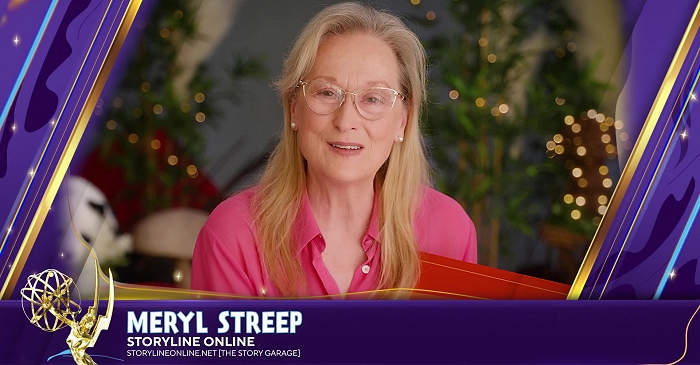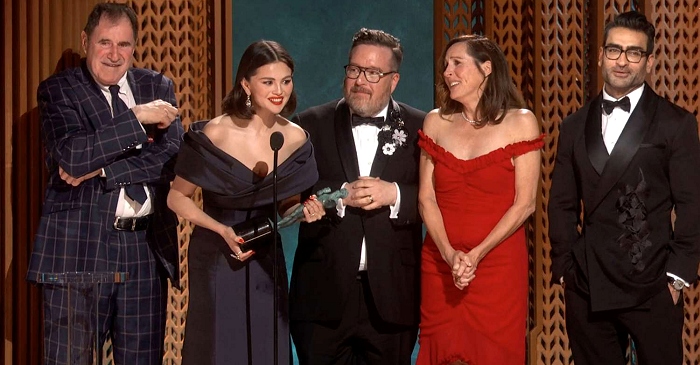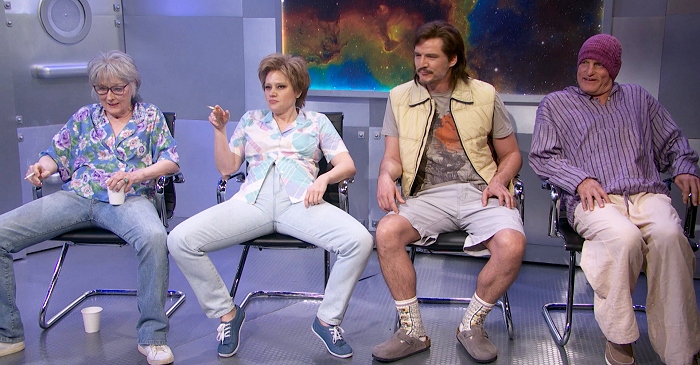|
Simply Streep is your premiere online resource on Meryl Streep's work on film, television and in the theatre - a career that has won her acclaim to be one of the world's greatest living actresses. Created in 1999, Simply Streep has built an extensive collection over the past 25 years to discover Miss Streep's body of work through thousands of photographs, articles and video clips. Enjoy your stay and check back soon.
|
|
24 Hours with Meryl Streep
Harper's Bazaar ·
January 1999
· Written by Conor McPherson
|
It was at the 1997 Cannes Film Festival that I first heard that Meryl Streep was to star in an Irish movie. I was there with a small film I had written, “I Went Doen”. When the Irish Independent producer Noel Pearson broke the news that Streep had agreed to be in his next feature, “Dancing at Lughnasa”, nobody could quite believe it – that she was coming to Ireland, that she was real, that she existed beyond all the immensely different characters she’s played. That’s the thing with Meryl Streep: She seems to change so completely from movie to movie, it’s difficult to get a handle on her. You go to see Jack Nicholson in a movie, you know what to expect – something brilliant and entertaining, but ultimately recognizable. With Meryl Streep, you don’t know what to expect.
These were the thoughts running through my head when I set out to talk to Streep about “Dancing at Lughnasa”. The movie, based on the play by Brian Friel about five sisters coping against the odds in 1930s Donegal, is told through the eyes of a young boy. Streep plays the eldest sister, Kate, a teacher who is trying to hold the family together, as financial problems, bitterness and loneliness are pulling them apart. Directed by Pat O’Connor (Circle of Friends, Inventing the Abbots), and with a cast that includes Kathy Burke, Sophie Thompson, Catherine McCormack and Michael Gambon, it’s a tale told with enormous tenderness. And it might be the best work Streep has done. Glenties, the town that inspired Friel’s play, is in a remote, inaccessible part of Donegal, untouched by Ireland’s current economic boom. The land is rocky and inhospitable for farming, and the local economy relies on the summer tourist trade. A small town with a strong community. Glenties is much as it would have been in the ’30s, when “Dancing at Lughnasa” is set. And it’s here, as aprt of the publicity for the film, that the cast and director are traveling from Dublin for a screening in the local school hall. For a huge star like Streep to visit a rural backwater such as this promises to be an unusual event, to say at least.
I am scheduled to interview Streep at her hotel before we set off for Glenties. But when I arrive, she is too exhausted to speak to me. She had flown in to Dublin for the previous night’s gala premiere and had been talking to journalists ever since. It’s the first of many false starts, but Gerry Lundberg, the movie’s Irish publicist, tells me he is sure I can speak to her in Glenties. When we get to the airport, I soon realize that there are two groups of people on the trip: those directly involved with the film, and the press. As the playwright who’s never interviewed anyone before, I’m starting to feel a little weird, as though I’m nervously trying to srash someone else’s party. The local plane is a twin-propeller vessel that looks like a big boat. As we board, I get my first look at Streep but studiously avoid catching her eye. People from Dublin are very good at ignoring famous people. They make us feel selfconscious for some reason. (Although I remember one time drinking in a pub in Dublin with some friends, Billy Joel came in and we all started shouting at him; don’t ask me why.) The engines seem to wheeze laboriously under the weight of our collective egos. But soon the rugged Donegal coastline comes into view – spectacular, mountainous, forbidding. It’s difficult to see how we can land anywhere, and I’m beginning to think this has been a dreadful mistake when suddenly we swoop over a beach and set down on what must be the only flat piece of ground for miles. The airport is in the middle of nowhere, but out on the tarmac a large crowd has already gathered. Local photographers, newsmen, politicians and ordinary people from miles around are clamoring for a glimpse of what must be the most famous person ever to visit here. Cameras flash from all directions. Eventually, Streep makes her way out of the airport and is whisked away toward Glenties. The rest of us board a coach. Besides me sits a full-time journalist, Justine. “When you cover an event like this do you feel like an outside?” I ask her. “Always,” she replies. Then she says, “Did you know she has a reputation for suddenly terminating interviews and kicking journalists out of the room is she doesn’t like the way it’s going?” Justine’s news flash does nothing to calm my nerves.
We drive through the most undulating countryside I’ve seen to get to Glenties. Outside the hotel another large crowd has gathered; dozens of children, more newsmen, TV crews and even a little flock of sheep. Lining the street are a row of beautifully restored cars from the ’50s. What this has to do with a film set in the ’30s is anybody’s guess. But someone local owns them and here they are. It’s like any expression of human endeavor is valid today. Whatever you have, you bring; you celebrate. And I’m struck at how surreal this meeting of cultures is; The world of rural Ireland meets the Hollywood A-list. It’s all beginning to feel like a bizarre dream. I go to my hotel down the road. (Everywhere in Glenties is either “up the road” or “down the road” because there only is one main road.) I also find out that Streep will be too busy to speak to me this afternoon. She and Friel are unveiling a commemorative plaque, and then she is giving a press conference for the local papers. I may get a chance to interview her tonight after the screening. I pass the time having tea with O’Connor who raves about Streep’s dedication and un-starry behavior – having flown in to Dublin on the red-eye, she was the first cast member to arrive at the morning read-through for “Lughnasa” when rehearsals started. “She’s got a very powerful, very quiet personality,” O’Connor says. “And she’s got a rawness in her nature. She takes in the very air around her.” At the press conference, I hear Streep speak for the first time. For someone who must be very tired, she is gracious, friendly and funny, enganging the room with good humor. The questions are direct, and Streep is frank in return. A local journalist asks how she would rate “Dancing at Lughnasa” among the movies she’s made. “It’s up there with my favorites”, she says. The journalist persisits. “Which one is your favorite?” Streep quickly answers, “Never mind.” Everybody laughs. I relax somehhat. Perhaps interviewing her won’t be so difficult after all. If I ever get to do it.
Next on the agenda is the screening at the local school hall. There’s just enough time for a quick drink in the hotel bar. I order a pint of Guiness, and while I’m waiting for it to settle, I become aware of someone at my shoulder. “Conor?” I turn and myself face-to-face with Streep. We shake hands and she says, “I just want to say I know this must be awful for you, I’m a massive fan.” It’s at times like this that you rediscover the meaning of the phrase “weak at the knees”. I sort of casually cling to the bar for dear life while she orders a pint of Guiness and we begin to chat. She’s busily learning to play the fiddle in preparation for her next movie, “50 Violins”. We talk about music, and I tell her how great I think “Dancing at Lughnasa” is. Then, before I can fix a time to do an interview, she is led away by tuxedoed members of the Meryl Streep Visit to Glenties Commitee to have her photo taken with them and their wives. They line up in the bar taking group and individual pictures. Those afraid they won’t get what they want are becoming slightly agressive, pushing through the room, grabbing at their wives to follow them. It’s all discreet, but it’s turning a little hysterical. These people have worked long and hard, and to miss this opportunity would be terribly disappointing. Fortunately Streep’s personal assistent steps in and decorum reigns again. Soon it’s time for the school hall screening, in a large modern building just outside the town. A large banner reads “Cèad mìle Failte”, Irish for “A hundred thousand welcomes”. The crowd again clamor for photographs. Uniformed students from the school are dotted about acting as stewards. Little girls run around with notebooks and pens and asking every stranger if they’re famous. The girls give each other autographs. A local woman tells me that on any ordinary day here you could walk up and down the street for hours and not meet anyone. It’s dinner time and the publicist tells me perhaps I can’t talk to Streep later on tonight. “Fingers crossed”. Then, at 10:00 PM, I am told I have half an hour with Streep. Lundberg has organized a quiet spot, and we should seize the moment. Streep passes me on our way out of the restaurant. She shouts, “Next!” to much laughter.
So here I am, finally alone with the woman at the center of so many people’s lives today, on whom so many hopes are pinned they fight for a piece of her. While assuring me that she is not mobbed like this in her Connecticut hometown. Streep stops me from feeling too sorry for her. “There’s a bit of complicity in this,” she says with a laugh. “I knew there’d be this type of media-circus. I bargain with myself. I say, I love this film, I will do whatever it takes to draw attention to it and make it an event people will want to come and see. This movie is brilliant and beautiful, and it deserves an audience.” She talks about the sadness of the character, Kate, the tragedy of a life judged to be devoid of worth. “It’s from all her lost chances,” says Streep, “and also that at a certain age her life is over. At least when she has her teaching job she has she self-esteem. And when that’s taken away she has nothing. And to be an unmarried woman without a child, not a widow even. Just a nothing, she’s a nothing in the world. A burden. Like in those Native American tribes when old people decide they’ve taken enough food from the group, they walk off.” Commenting on the detail of the movie, which is filles with small, evocative gestures, Streep likens O’Connor’s film to an art-work. “When I watch a film, I usually know where they’re going to ‘yank’ me,” she says. “Where they’re going to pull the strings and make me get upset. But with this film I had no idea when this stuff was coming. I missed a lot of little things when I saw it for the first time, because I watched it the way I watch other movies, which is like (she snaps her fingers rapidly) ‘Show me, show me, show me, show me. Okday. What, what, what, what’. And you dan’t watch this movie at that place. You’ve got to look hard at it. Like a painting. Like a novel. And it deserves that. What struck me is that there are very few directors who give actors the luxury of that extra… glance. And because of that, the film is so forgiving of people. It’s just so filled with forgiveness for all these minor and major cruelties that we inclict on each other.”
Trying to fathom her famous technique, I ask Streep about O’Connor’s description of her as having “and acute sense of rightness” as an actress, in every gesture, down to how she sits in a chair. “I don’t see it as rightness or wrongness,” Streep replies. “I don’t feel I have a choice. I don’t get an option. Kate would only sit this way. It wouldn’t be like me, and then I’m only comfortable sitting that way. I don’t know how to describe it. It’s just a great abandon, you know! I love it. It’s like falling in love. I love this character, Kate.” I remind her that Kate is judgmental and bitter, in a way that strikes me as peculiarly Irish. At one point Kate says “I’m a righteous bitch, amn’t I?” “Yes, but I’m judgmental too,” says Streep. “I think we all are. But we’re also all forgiving.” There’s no more time. Lundberg has arrived with another journalist, and I have to leave. A little later on, Streep is to attend a performance by a local group commemorating the pagan festival called Lughnasa, a celebration of the harvest. This happens in a jam-packed function room where her arrival causes shrieks of delight. Again the crowd mill around, taking photographs. Streep seems to vanish among the heaving bodies and then appears on the stage behind a microphone. She thanks everyone and says she wishes she could stay longer, she’s had a wonderful time. There are huge cheers, and we all settle down to watch the performance. It’s a great mixture of songs, narration and dance, evoking and ancient tradition of drinking, carousing and winning your lover’s hand. The performance is simple, direct and moving. A gang of little girls sit on the floor, their backs to the stage, staring up at Streep for the entire show.
And I’m thinking about her visit here as its own kind of pagan ritual. It’s been a fraught but ultimately life-affirming day, a mixture of confusion and heartfelt enthusiasm. All the certainities in life, once embodied in religious belief and ceremony, now oddly seem embodied in celebrity, and everyone wants to be near it. The next morning I’m awakened by the still-exited chatter of the local children on their way to school. On the radio our most seasoned national broadcaster, Gay Byrne, is lamenting the fact that he never got to meet Streep before her departure for the States. He wanted just once to put his arms around her and kiss her cheek. He said he had been practicing on his wife last night. Streep’s visit there as a national event. Her celebrity is a responsebility she carries with great charm and fellow feeling. I had felt dishonest, masquerading as a journalist when I met her, but she put me at ease. I hope she enjoyed her flying visit to Ireland. I know Ireland enjoyed her. Many houses in Donegal will now have mounted framed snapshots of her in their parlors and living rooms, And I know they’ll be talking about her for many years to come. And perhaps even more so at harvest time, the festival of “Lughnasa”.


